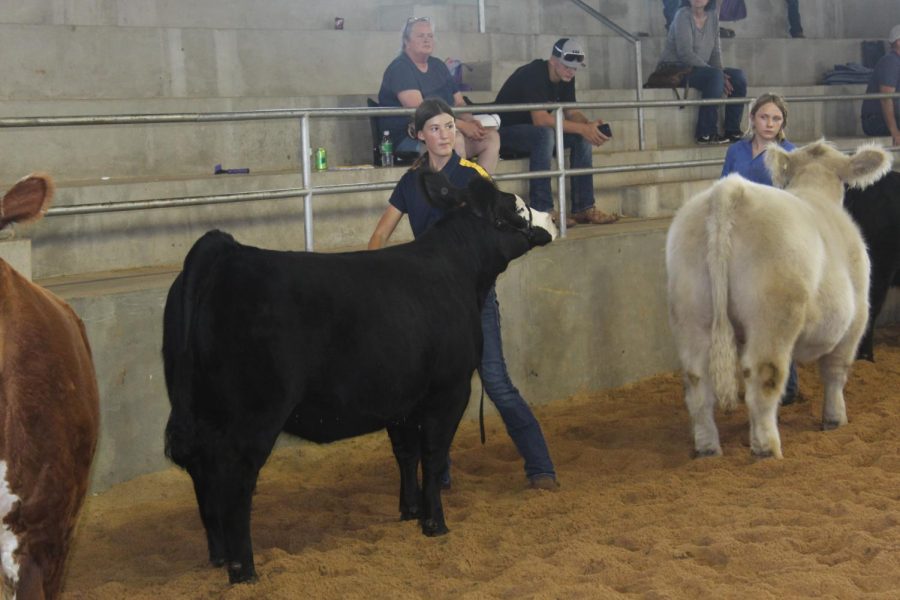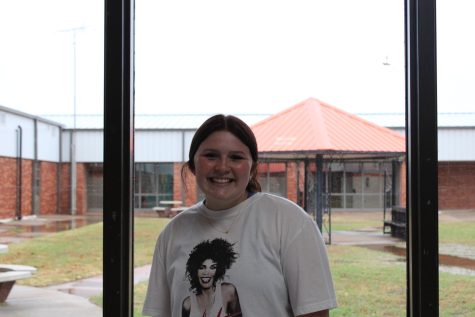Livestock Work Never Stops
Though there are not any shows this week, kids with show animals are still working to get their animals ready for the winter and spring stock shows. Kids with show animals are just trying to make it through the week doing everything that is required to own a show animal.
Exhibitors with cattle should be constantly working with their animals, including walking and working on setting them up at least every day or every other day. Walking show calves helps them learn to walk with the exhibitors and stay calm when they are in a crowded situation. Setting up the calf can help them get used to standing a certain way, and scratching the calf’s brisket, or belly can help them relax. It isn’t easy though, and a lot can happen when working on showmanship.
“The hardest part about having a show calf is them being stubborn and not wanting to walk, and when she does, she wants to walk on my feet or heels. She is good about getting in her show stance though since I’ve worked with her, and she’s gotten better about it,” Kasidee Pope, cattle showman, said.
Exhibitors usually have to wash their calves every day, but sometimes scheduling can be a problem. Washing at least two to three times a week can keep the calf clean and their hair tamed. When washing, exhibitors have to make sure when they foam the calf they get them scrubbed down and all the dirt and grime loose. Using additional shampoos such as whitener or moisturizer is also good to use especially if said calf has dandruff, dried out hair, or white hair. When using the blower on the calf, exhibitors have to make sure they get all the water off, the hair dry, and the hair tamed and not crazy. It’s also fun fluffing their hair and making them into giant balls of fluff. Show cattle can catch pneumonia if it’s cold or get a black fungus that irritates the skin if exhibitors neglect the water after several washes.
Brushing and using spray conditioners when exhibitors can’t wash can help get their calf the hair care they need, but it’s better to just wash them. Exhibitors need to feed their calves every day because it’s common sense and it helps them stay full and maintain deep bellies.
“It’s hard trying to find the time to do what you want because you have to constantly be working with them. Having chores and football also makes it hard to do a lot of the things required to own a show heifer since scheduling can be a problem,” Hayden Thompson, cattle exhibitor, said.
Exhibitors with goats and sheep are also constantly working with their animal’s hair and walking them around to ensure that they will walk in the show ring. Wrapping sheep’s legs to keep their shags (the fluffy hair on their legs) in perfect condition is also important. Washing should only happen around a few times a week since sheep can get fungus or catch pneumonia easier than cattle. That’s why it’s important to put blankets and leg wraps on them to ensure they stay healthy and their hair or wool growing.
Exhibitors with sheep also have to work on bracing the sheep and getting them to brace when they want them to. The best thing to maintain when it comes to sheep is a workout schedule and weight. Sheep need to be walked at least 3 times a week to maintain their muscles and keep them walkable when it’s time to hit the show ring. Feedings can also be a bit difficult with sheep and goats since different breeds take different amounts of feed, and it’s also hard to get proportions right. If exhibitors feed them too much or too little it can affect their quality.
“The hardest part about owning sheep is the feedings because different breeds will eat different amounts and need different supplements. It’s also difficult when the ewes eat less than the wether, and he doesn’t gain as much weight as them,” Emma Hoffman, sheep exhibitor, said.
When it comes to goats, they are the same as sheep when it comes to a workout schedule, they need to be walked at least three times a week to maintain muscle. When in a show ring during a goat show, making sure the goat will walk is the most important thing, if the goat doesn’t walk, the judge can’t evaluate them on that aspect.
“Since I have Football practice, I usually have to deal with the goats in the evening or for a little bit on the weekend. They don’t like being caught sometimes, so I spend a good amount of time just working with them to make them walk, and they still don’t do that anyways,” Nick Sullins, goat showman, said.
When it comes to washing goats many people try to take them as seriously as possible and wash them every day to keep their hair growing and white, and just like cattle sometimes it’s hard trying to do that with a busy schedule. When washing goats it’s important that exhibitors work the hair into a motion that makes the hair wrap around and upward. Putting leg wraps on goats, just as with sheep, also helps to make their leg hair grow.
“The hardest part about owning a show goat is probably feeding them the right amount, because if you feed them too much, they get fat and if you don’t feed them enough, they get skinny, and exercising them enough since they need to have good muscle on them,” Amanda Schoonmaker, goat and sheep exhibitor, said.
When it comes to pigs, it’s all about skincare, and oiling the skin every day. Maintaining a clean pen and clean bedding means the pig is cleaner, and exhibitors only have to wash their pigs a few days a week. Walking their pigs every day or every other day is also really important. It helps them learn to drive and move around for longer. It also gives the showmen an opportunity to teach the pig to get their heads up while walking.
“The hardest thing about pigs is that they can be stubborn. If they don’t want to do something, they’re not going to do it. There are no leads you can put on them, so it’s hard to get them to go in the right direction. If pigs have floppy ears, they can’t see very well, so they are especially difficult,” Blair Dowell, swine exhibitor, said.
Above all the hardest thing to do with any show animal is getting the judge’s attention and catching his/her eye, and it’s hard to tell what to expect since all judges have their own opinion on what makes a good show animal. In the show ring, anything can happen. One wrong move and the exhibitor could have a loose animal running around. It’s important to constantly be looking at the judge and checking to see if said show animal is in the right position.
“When it comes to showing pigs it’s hard to keep them concentrated with all that’s going on in the show ring and making sure the judge is impressed with them,” Maggie Clark, swine showman, said.









